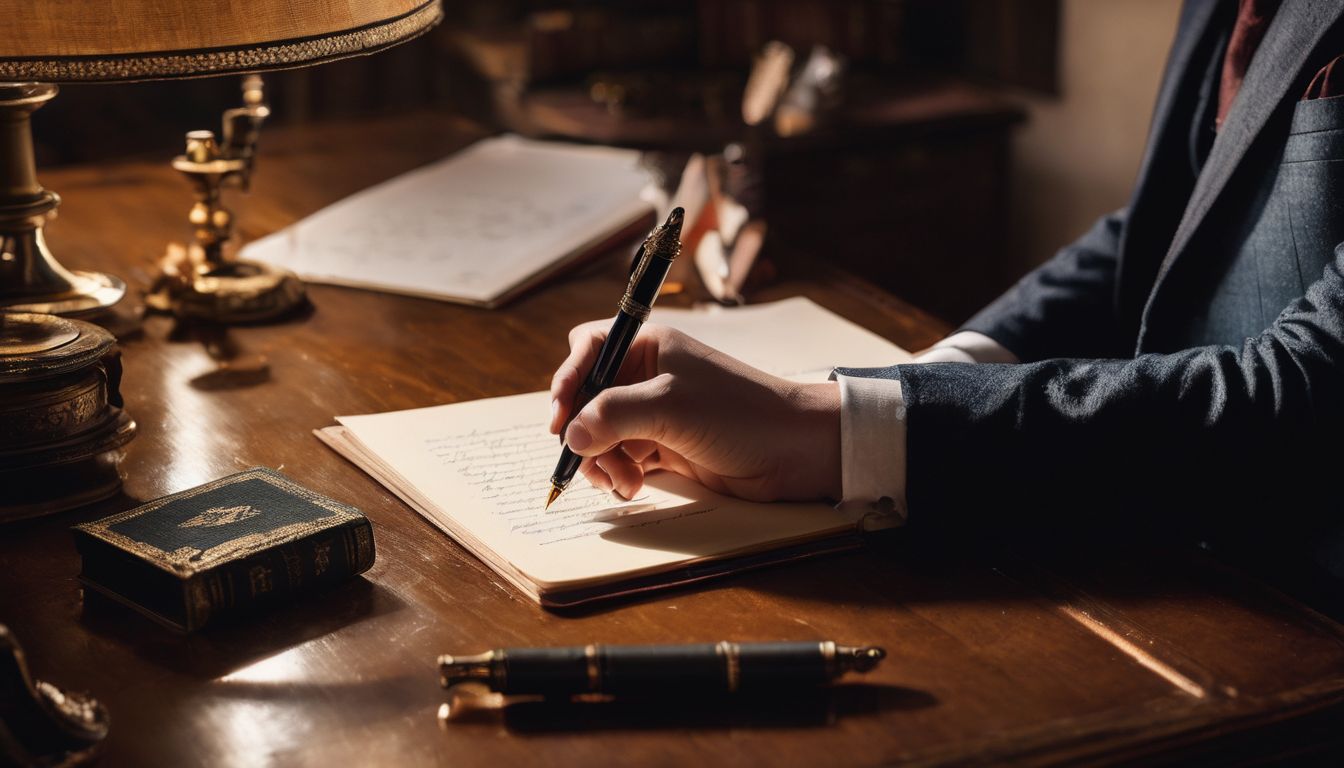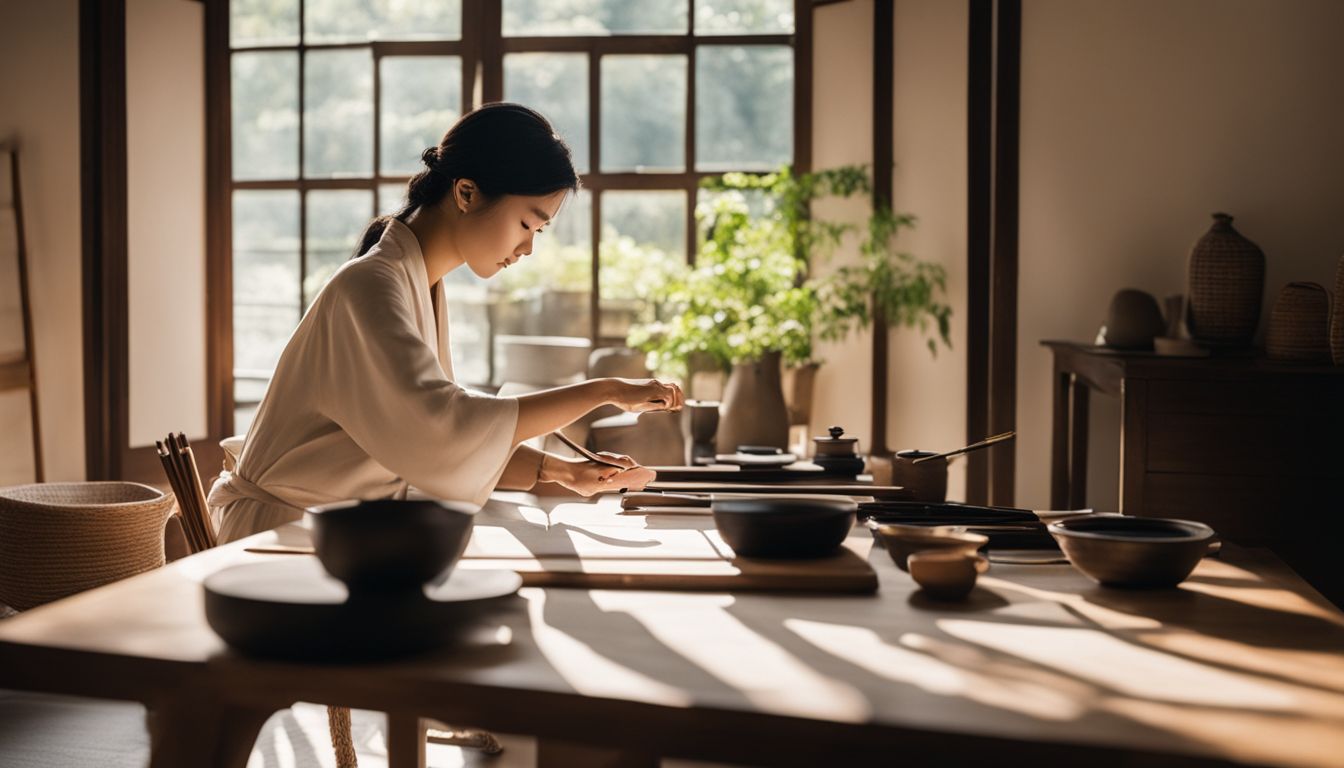Have you ever found yourself typing at a keyboard, feeling as if there’s a disconnect between your thoughts and the words that appear on screen? It’s a sensation I’ve come to know all too well.
Yearning for something more tactile, my quest led me to the classic elegance of fountain pens. In this piece, I’m excited to share insights into how these sophisticated tools can elevate your writing from mere text to an expressive work of art.
So let us embark on a journey together and rekindle the intimate joy found in ink caressing paper!
Key Takeaways
- Fountain pens have been around since Petrache Poenaru invented the first one in 1827, and Lewis Waterman improved ink flow in 1884.
- Writing with a fountain pen adds personal style and expression to your words because you can choose from different nib sizes and ink colors.
- To find the right fountain pen, consider the nib size that fits your writing style along with the pen’s material for comfort and durability.
- High – quality ink is crucial for a smooth writing experience with a fountain pen; it prevents clogging and ensures consistent ink flow.
- Regular cleaning of your fountain pen is important to maintain its function over time, preventing issues like clogs or leaks.
History and Evolution of Fountain Pens

Fountain pens started changing the writing game over a century ago. Petrache Poenaru got things rolling in 1827 with his invention of the first fountain pen. This tool could carry its own ink, a big shift from dipping pens into bottles every few words.
Later on, Lewis Waterman made a huge leap in 1884. He came up with a way to control ink flow more reliably so writers wouldn’t get those annoying ink blots on their papers.
These early innovators laid the groundwork for what we have today. As years passed by, inventors added new twists to fountain pens, making them even better. They tinkered with materials and designs to improve how these pens felt in our hands and wrote on the page.
Nib sizes and shapes evolved too, giving us all kinds of options for different handwriting styles and uses, from neat notetaking to fancy calligraphy.
The Appeal of Writing with Fountain Pens

Writing with fountain pens offers a unique personal style and expression that can’t be replicated by standard ballpoint pens. The connection to the art of writing is enhanced through the smooth, fluid experience of using a fountain pen, making it an appealing choice for those who appreciate the beauty of written language.
Personal Style and Expression
Fountain pens are like a magic wand for your handwriting. They turn every word into a little piece of you. Your mood, personality, and flair come alive on the page. The way I hold my pen and press down on the paper makes each letter unique.
And there’s more – with different pen nibs and flex nibs, I get to play around with thickness and emphasis in my writing. It feels like painting where strokes can be broad or fine, just by changing how I use my fountain pen.
This isn’t just about words; it’s about making them dance! My personal expression doesn’t stay locked in my head—it flows out onto paper for everyone to see.
Using these elegant writing instruments helps me focus better too. There’s something special about seeing ink spread across a page that keeps me connected to what I’m doing. Plus, so many choices in fountain pen inks mean I can match colors to what I’m feeling or the message I want to convey—talk about wearing your heart on your sleeve..or should I say your paper?.
Connection to the Art of Writing
Using a fountain pen is like taking part in a timeless dance of ink and paper. It’s an intimate expression of my thoughts and emotions, flowing effortlessly from the nib. Each stroke mirrors the unique rhythm of my hand, allowing me to create writing that’s filled with character.
I find myself more engaged in writing when I use a fountain pen. My fingers guide the pen gently across the page, making every word deliberate. This form of writing feels more artful than typing on keys or scribbling with ballpoints.
It brings mindfulness to my letters and invites creativity into everyday tasks.
Choosing the Right Fountain Pen
– Understanding different nib sizes and materials is essential for finding the perfect fountain pen. It’s all about finding one that suits your writing style and feels comfortable in your hand.
Understanding Different Nib Sizes
When choosing a fountain pen, understanding different nib sizes is crucial for finding the right fit. Here’s a detailed guide to the various nib sizes and their impact on writing:
- Fine Nib: Offers precise and thin lines, suitable for small handwriting or detailed work.
- Medium Nib: Strikes a balance between fine and broad, suitable for everyday writing and versatility.
- Broad Nib: Produces thick lines, ideal for larger handwriting or adding emphasis.
Materials and Construction
Understanding different nib sizes is crucial, but considering the materials and construction of a fountain pen is equally important. The choice of materials, whether it’s resin, metal, or celluloid, impacts durability and performance.
High-quality construction prevents ink clogging and ensures consistent ink flow. Material composition can significantly affect the overall comfort and writing experience. It’s essential to grasp these aspects for proper maintenance over time.
The construction isn’t just about aesthetics; it directly influences how well a fountain pen performs in the long run. High-quality materials ensure smooth functioning and minimize potential issues like inconsistent ink flow or premature wear and tear.
How to Choose the Right Fountain Pen for You
As you explore the world of fountain pens, consider various factors to find the perfect fit for your needs and preferences:
- Consider different nib sizes to determine your desired line thickness and writing style.
- Explore materials such as resin, metal, or acrylic, considering weight and design that complement your grip and hand size.
- Personalize your writing experience by selecting a pen that reflects your individual style and personality.
- Assess the ink reservoir options – cartridge or converter – based on your usage frequency and preference for ink colors.
- Ensure the ergonomic design of the pen aligns with your posture, hand size, and writing speed.
- Exploring Ink Options for Fountain Pens…
Exploring Ink Options for Fountain Pens
Let’s dive into the world of fountain pen inks, exploring different types, colors, and properties that can elevate your writing experience. Discover how the right ink can enhance your personal style and expression with a fountain pen.
Read on to uncover the importance of ink quality for an exceptional writing experience.
Types of Fountain Pen Inks
Fountain pen inks come in various types, each with distinct properties and uses. Here are the different types of fountain pen inks to consider:
- Dye-based Inks: These inks offer a wide range of vibrant colors and are known for their quick-drying properties, making them ideal for everyday use.
- Pigment-based Inks: Unlike dye-based inks, pigment-based inks contain solid particles that sit on the paper’s surface, providing more resistance to fading and water damage.
- Iron Gall Inks: Known for their permanence and historical significance, these inks produce a unique color change as they oxidize over time, adding character to written documents.
- Shimmering Inks: These inks contain sparkling particles that add a touch of shimmer and luxury to handwritten notes and calligraphy projects.
- Bulletproof Inks: Designed to be water-resistant and fade-proof, bulletproof inks maintain their legibility even when exposed to moisture or sunlight.
Choosing Colors and Properties
When choosing fountain pen inks, it’s essential to consider the color palette, opacity, shading, and drying time. Here’s a detailed guide to help you explore the diverse range of options available:
- Consider the Color Palette: Look for inks that offer a wide array of colors to match your personal style and creative expression. From classic blues and blacks to vibrant reds and greens, the color range should reflect your individuality.
- Explore Opacity and Shading: Some inks have varying levels of opacity, allowing for unique layering effects and subtle gradations in hue. Consider how the ink will appear on different paper types and how it complements your writing style.
- Evaluate Drying Time: The drying time of an ink can impact its usability. Rapid-drying inks are ideal for those who require quick results without smudging, while slower-drying inks may be preferable for achieving specific artistic effects.
- Importance of Ink Quality: High-quality inks from reputable brands ensure smooth flow and prevent clogging, prolonging the life of your fountain pen while delivering consistent performance.
- Compatibility with Pen Construction: Certain pens may react differently to specific ink formulations due to their construction materials. It’s crucial to select inks that are compatible with your fountain pen’s components to maintain optimal functionality.
- Understanding Ink Properties: Beyond color, factors like water resistance, feathering, bleed-through, and archival quality should be considered based on your intended use and preferences.
- Personalizing Your Writing Experience: Ultimately, choose fountain pen inks that resonate with you creatively and enhance the joy of writing with every stroke.
Importance of Ink Quality
When it comes to using fountain pens, the quality of the ink plays a vital role in ensuring smooth and consistent writing. Low-quality inks can clog the pen’s nib and affect its performance, leading to skipping or uneven ink flow.
Opting for high-quality inks from well-known brands ensures compatibility with the pen’s construction, preventing potential issues such as clogging and maintaining optimal writing experience.
Hence, sticking to reputable brands and reading reviews can guide you in choosing the right ink for your fountain pen.
Caring for Your Fountain Pen
When it comes to caring for your fountain pen, it’s important to regularly clean and maintain it to ensure smooth and consistent ink flow. Proper storage and safety measures will also help preserve the quality of your pen over time.
Cleaning and Maintenance
Cleaning and maintaining your fountain pen is crucial for its performance and longevity. Regular care ensures smooth ink flow and prevents issues like clogging, skips, or leaks.
- Disassemble the pen carefully to access all parts without causing damage.
- Flush the pen with clean water to remove residual ink and debris from the nib and feed.
- Gently remove stubborn ink residue using a soft cloth or specialized cleaning tools, avoiding abrasive materials that could scratch the pen.
- Allow the pen to air dry completely before reassembling it to prevent moisture – related issues.
- Store the pen capped in a vertical or horizontal position to maintain proper ink flow and protect the nib from damage.
- Avoid exposing the pen to extreme temperatures or direct sunlight, as these can affect its performance and longevity.
- Regularly refill or replace the ink, following manufacturer recommendations for specific models, and lubricate internal mechanisms when necessary.
Storage and Safety
To keep my fountain pen in top condition, I always make sure to cap it securely after use. Extreme temperatures can damage the pen, so I store it in a cool, dry place. Regular maintenance like cleaning and occasional lubrication keeps the internal mechanisms working smoothly.
By capping my pen and storing it away from extreme temperatures, I protect it from potential damage. Maintenance such as regular cleaning and occasional lubrication ensures that my fountain pen remains in excellent condition for smooth, consistent writing.
Troubleshooting Common Issues
Dealing with Fountain Pen Problems:
- Inconsistent Ink Flow: Ensure the nib is clean and free from ink buildup to maintain a steady flow. Try adjusting the angle and pressure of the pen for optimal performance.
- Nib Skips: Check for any misalignments or damage on the nib, and gently realign it if needed. Use high-quality, lubricated inks to prevent skipping.
- Ink Leakage: Tighten the pen’s components securely without over-tightening, as this can cause leaks. Consider replacing the cartridge or converter if leakage persists.
- Clogging Issues: Use high-quality fountain pen inks that are compatible with your pen to prevent clogs. Regularly flush and clean the pen to remove any dried ink or particles.
- Addressing Common Maintenance Needs: Keep your fountain pen clean by flushing it after every refill, and use silicone grease sparingly on the threads to prevent leakage.
- Resolving Nib Issues: If experiencing scratchiness, consult a professional to adjust or smooth out the nib for optimal writing experience.
- Adhering to Proper Storage Practices: Store your fountain pens horizontally to prevent ink from settling or drying in one part of the reservoir, potentially causing flow issues.
Enhancing Your Handwriting with Fountain Pens
Proper grip and posture are essential when using a fountain pen to enhance your handwriting. Practice different handwriting techniques, such as cursive or print, to find the style that suits you best.
You can also use fountain pens for calligraphy to further explore the art of writing.
Proper Grip and Posture
Achieving the ideal grip and posture enhances handwriting with fountain pens. When holding a fountain pen, place it between the thumb and index finger… Keep the pen at a slight angle to the paper surface for optimal ink flow. Maintain a relaxed grip to minimize hand strain… Avoid pressing down too hard on the paper, allowing the pen’s weight to guide your writing… Position your arm and wrist ergonomically, preventing undue strain during extended writing sessions.
Practicing Handwriting Techniques
After mastering the proper grip and posture, practicing handwriting techniques is crucial for improving your penmanship with a fountain pen. Here are some effective techniques to enhance your handwriting:
- Start with basic stroke exercises to build muscle memory in your hand and arm.
- Experiment with different letter forms and practice consistency in letter height and spacing.
- Focus on maintaining a light touch on the paper to avoid heavy – handed writing.
- Engage in regular drills such as loops, spirals, and figure eights to refine your control over the pen.
- Consider using lined or grid paper to aid in maintaining uniformity and alignment.
Using Fountain Pens for Calligraphy
I love using fountain pens for calligraphy because of the flexibility and control they offer. Experimenting with different nibs allows for creating thick and thin strokes, resulting in unique and expressive handwriting.
- Choose a fountain pen with a flexible nib to achieve varying line widths for calligraphic styles such as italic or copperplate.
- Experiment with different ink colors and properties to enhance the visual impact of your calligraphy, ensuring the ink quality is suitable for smooth flow and vibrant hues.
- Practice proper grip and posture when using the fountain pen for calligraphy to maintain control and precision in creating intricate lettering.
- Join online communities or local clubs dedicated to fountain pens and calligraphy to exchange tips, share work, and gain inspiration from other enthusiasts.
- Attend pen shows or events where you can explore a wide range of fountain pens, inks, and accessories tailored specifically for calligraphy enthusiasts.
The Fountain Pen Community
Engaging with the fountain pen community can open up new opportunities for learning and sharing your passion for writing instruments. There are online forums, local clubs, and even pen shows where enthusiasts gather to discuss their favorite pens and inks.
Joining these communities can provide invaluable insights, tips, and a sense of camaraderie among fellow aficionados.
Interested in diving deeper into the world of fountain pens? Check out my full blog post to uncover more about this fascinating writing tool.
Online Communities and Forums
Engaging in online communities and forums like Reddit’s /r/fountainpens, Fountain Pen Network, and Instagram’s fountain pen community offers valuable opportunities to connect with fellow enthusiasts, learn from experienced users, and expand knowledge and collection. These platforms provide a supportive environment for sharing experiences, asking questions, and discussing various aspects of fountain pens. Here are the essential benefits of being part of the fountain pen community:
- Exchange tips and tricks for caring for fountain pens, troubleshooting common issues, and enhancing handwriting techniques.
- Explore different types of pens, inks, paper, and accessories with the support of like – minded individuals.
- Foster a sense of community and camaraderie among members by expressing creativity and exploring new writing styles.
Local Fountain Pen Clubs
Local fountain pen clubs are a fantastic way to connect with fellow enthusiasts who share your passion for writing instruments. These clubs offer unique opportunities for in-person interactions, workshops, and engaging events where members can swap pens or try out new inks.
Being part of a local fountain pen club fosters a sense of camaraderie within the community and provides valuable avenues for learning about different pens, inks, and techniques through real-life experiences.
Attending these clubs lets you immerse yourself in the world of fountain pens and discover new aspects of this art form while making meaningful connections with like-minded individuals who appreciate the beauty and tradition of handwriting.
Attending Pen Shows and Events
Now, let’s explore the excitement of attending pen shows and events, where enthusiasts gather to celebrate the art of writing and discover a treasure trove of products and techniques:
- Pen shows and events bring together a passionate community of pen lovers, collectors, retailers, and manufacturers, offering an immersive experience into the world of fountain pens.
- These gatherings provide unique opportunities to try out a wide range of pens, inks, and writing supplies from various brands and materials, fostering a deeper appreciation for the craftsmanship behind these exquisite tools.
- Workshops and demonstrations at these events offer practical insights into pen care, handwriting enhancement, calligraphy techniques, and the art of choosing the right fountain pen.
- The vibrant atmosphere at pen shows encourages exploration and discovery, allowing attendees to expand their knowledge about different ink types, nib sizes, and innovative writing utensils.
- Engaging with fellow enthusiasts at these events can lead to valuable exchanges of tips, recommendations for retailers or products that are not commonly found in mainstream stores.
- Participating in pen shows may also open up opportunities to swap or purchase unique pens or limited – edition inks that are often exclusive to such gatherings.
- Attendees can use these events as platforms to engage with industry professionals to gain further insight into emerging trends or new developments in the world of fountain pens.
- Furthermore, attending these events can be an exciting way to connect with like – minded individuals who share a common passion for handwriting and all things related to fountain pens.
Conclusion
In conclusion, writing with a fountain pen is an art that offers a deeply personal and gratifying experience. From choosing the perfect pen to exploring a world of inks, caring for your fountain pen, and elevating your handwriting, the journey is both practical and enriching.
So go ahead, embrace the elegance of a fountain pen, let it inspire you as you put words to paper – discover the timeless allure of this classic writing tool. Whether for daily use or creative expression, the fountain pen brings joy to writing and connects us to its enduring tradition.
If you’re ready to find the perfect writing instrument for yourself, be sure to check out our guide on choosing the right fountain pen.
FAQs
1. How do I choose the right fountain pen for calligraphy?
Look for a quality calligraphy pen that suits your grip and writing style. Consider the Lamy Safari for beginners or the Bic Cristal if you’re on a budget. The key is to find one with water-based inks that flow smoothly.
2. What’s the proper way to hold my fountain pen when writing?
Hold your fountain pen at a comfortable angle, using your elbow as an anchor point. Keep your palm relaxed and control the pen mainly with your fingers for better precision.
3. Can I use any ink with my calligraphy pens?
Choose ink wisely! Water-based inks are best for most fountain pens because they won’t clog up like pigments could do over time. Always check if the ink is compatible!
4. Why does my handwriting look different with a quill pen versus a rollerball?
The unique flexing of a quill or calligraphy nib creates varying line widths, adding flair—such as serifs—to letters, unlike rollerballs which have consistent lines due to their ballpoint tips.
5. Where can I learn more about improving my technique with fountain pens?
Join forums or subreddits focused on calligraphy and fountain pens—they are treasure troves! Experienced members often share techniques; tweezers might get mentioned for fixing nibs, but really… it’s mostly tips on strokes and angles.




Leave a Reply
You must be logged in to post a comment.